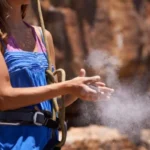Have you ever wondered how professional rock climbers keep their hands dry and prevent them from slipping off a rock? The answer is chalk! Chalk is an essential part of any climber’s gear—it helps them to grip the rocks better, allowing them to stay on the wall for longer. But how does climbing chalk work? Let’s explore the mysterious power of climbing chalk.
How Does Climbing Chalk Work?
Climbing chalk is essential for many rock climbers, giving them the grip they need to scale a wall. But how exactly does it work? Well, when a climber rubs their hands in chalk, the powder absorbs sweat and their skin’s natural oils, leaving a dry coat on their hands that reduces slip.
It can also reduce fatigue by reducing the force needed to keep a grip on the wall. In addition to being used by climbers, this material has found its way into numerous sports, such as gymnastics and weightlifting, proving its effectiveness time and time again.
It also doesn’t hurt that it’s incredibly affordable – so if you’re looking for an edge in climbing or other physical activities, giving chalk a try might be worthwhile!
Also Read: Is Climbing Chalk Bad For The Environment?
The Science Behind It All
The secret behind why chalk works so well lies in its composition. Most climbing chalk is made of magnesium carbonate, which has a high absorption rate.
This means that as soon as you put some on your hands, it will absorb all the moisture in your skin (i.e., sweat) and lock it away. This leaves your palms dry and grippy—perfect for gripping the rocks when climbing!
Also Read: How Is Climbing Chalk Made?
Why Is Chalk So Popular?

Climbing chalk has been around since at least the early 19th century. Still, its modern popularity can be attributed to two key factors: Its effectiveness in helping climbers get a secure grip on rocks and its affordability compared to other climbing aids (like gloves).
Plus, thanks to advances in technology over the years, several different kinds of climbing chalks are available on the market with varying levels of absorbency and texture.
Also Read: How Much Does Rock Climbing Chalk Cost?
What Does Chalk Do?
Climbing chalk absorbs sweat from the hands, making them less slippery on the rock face. The chalk then helps provide traction between your skin and the surface of the rock, which makes it easier to hold onto small crevices and cracks.
It also helps reduce friction, which can be incredibly useful when maneuvering over difficult climb sections. In addition to improving grip, climbing chalk can help prevent blisters and calluses on your palms.
This is especially important for climbers new to the sport, as their hands may not be used to repeatedly gripping small edges on rocks and might suffer abrasions. This way, chalk can reduce pain while helping climbers develop better techniques.
Finally, climbing chalk also has psychological benefits for its users. Having chalky hands can give climbers more confidence that they won’t accidentally slip off during their climb, making them feel more secure and relaxed throughout their ascent or descent.
This increased confidence can lead to better performance overall—both in terms of safety and success rate of completing a climb.
Also Read: How Long Does Climbing Chalk Last?
Does Climbing Chalk Damage Rock?
When it comes to climbing, using chalk has been a popular choice for climbers to increase their grip and decrease friction on the wall. However, people wonder if chalk harms or damages the wall after prolonged use. The short answer is that it depends.
Firstly, your rock type matters — some are more fragile than others and better suited to brushing after each climb. Also, while it may seem like a small amount of chalk overall, if thousands of routes have been climbed at one particular spot over an extended period without maintenance, this can accumulate and settle in cracks, thereby breaking them down.
That being said, there are plenty of ways that climbers can reduce or even avoid any potential damage from climbing chalk. For instance, you can use ‘low dust’ varieties along with natural alternatives that don’t adhere to it too much, such as vegetable-based oil or liquid magnesium carbonate (MgCO3), which allows for better absorption and weathering of chalk deposits into the rock.
Also Read: What Does Climbing Chalk Do?
Conclusion
In conclusion, Now you know how does climbing chalk work. We’ve learned that climbing chalk is essential for any serious rock climber. Not only does it help keep their palms dry and grippy while they climb, but its affordable price tag makes it an attractive option compared to other aids like gloves or taping up their fingers.
So if you’re looking for a way to get more secure footing while scaling those walls, try some quality chalk! You just might be surprised by what a difference it can make!



